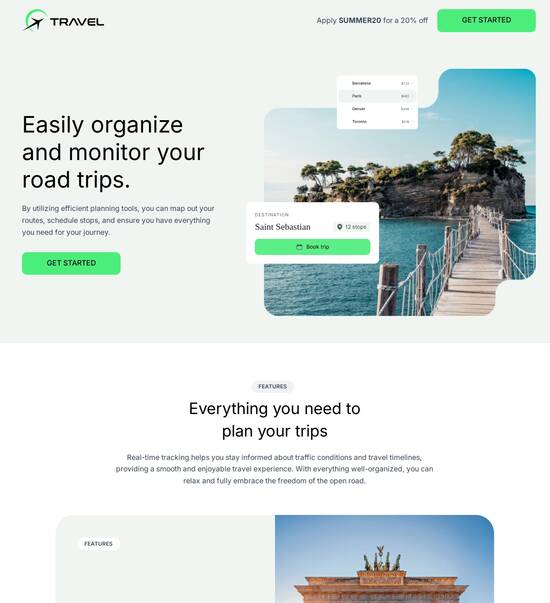
One page website template for food distribution companies
Explore Similar TemplatesAbout template
Unlock the potential of our one page website template for food distribution companies: flexible designs for all niches.
Recommended templates

Easy to build without coding
With the intuitive drag-and-drop builder, anyone on your team can create high-converting pages without any knowledge of code or design. Make enhancements to your landing page with custom widgets using Javascript, HTML/CSS, or third-party scripts.

Multiple layouts for any industry and goal
Select from 500+ landing page layouts built to boost conversions across industry-specific scenarios. Customize them by adjusting fonts, adding images, and generating on-brand content with the AI assistant. Quickly scale with Instablocks® and Global Blocks that you can save, reuse, and update globally.

Loads fast and looks polished on any device
Every template is responsive, which means they present professionally on any device and load blazingly fast with our Thor Render Engine. You can also power them up with Google AMP technology to deliver an unparalleled mobile experience and drive higher conversions.

Robust analytics & experimentation
Get real-time updates and reporting across all your devices, showing the number of visitors, conversions, cost-per-visitor, and cost-per-lead. Launch AI-powered experiments, run A/B tests, and use heatmaps to analyze user behavior, then optimize your landing page to maximize conversions.







Easy to build without coding
With the intuitive drag-and-drop builder, anyone on your team can create high-converting pages without any knowledge of code or design. Make enhancements to your landing page with custom widgets using Javascript, HTML/CSS, or third-party scripts.
Multiple layouts for any industry and goal
Select from 500+ landing page layouts built to boost conversions across industry-specific scenarios. Customize them by adjusting fonts, adding images, and generating on-brand content with the AI assistant. Quickly scale with Instablocks® and Global Blocks that you can save, reuse, and update globally.
Loads fast and looks polished on any device
Every template is responsive, which means they present professionally on any device and load blazingly fast with our Thor Render Engine.
Robust analytics & experimentation
Get real-time updates and reporting across all your devices, showing the number of visitors, conversions, cost-per-visitor, and cost-per-lead. Launch AI-powered experiments, run A/B tests, and use heatmaps to analyze user behavior, then optimize your landing page to maximize conversions.
All the features you need to build lead-generating landing pages
Explore more featuresLearn how to build top-performing landing pages for any goal
FAQs
Leading the way in building high-performing landing pages





An effective step-by-step guide for leveraging Instapage in your landing page strategy
When it comes to digital marketing, using Instapage’s powerful landing page and conversion rate optimization (CRO) platform can significantly enhance your campaign results. With simple, intuitive tools tailored for marketers in sectors like business services, tech, and education, creating high-converting landing pages is just a few clicks away.
Understanding the power of Instapage landing pages
Instapage offers over 100 high-converting templates ready for customization, meaning no more starting from scratch. This extensive library empowers users to create effective landing pages quickly, making it easier for marketers in sectors such as financial services or advertising to capture leads efficiently. Here's what makes Instapage unique:
- Comprehensive Template Library: Choose from over 100 customizable templates that are designed to meet various marketing needs, ensuring that your page captures visitor attention immediately.
- User-Friendly Interface: Build pages effortlessly without the need for coding expertise, making it accessible for small teams and even solo marketers.
- Integration with Leading Marketing Tools: Instapage easily integrates with your favorite marketing tools, making the data-driven optimization and lead tracking seamless.
Step 1: Setting up your Instapage account
Begin by signing up for an Instapage account. The onboarding process is straightforward and ensures you know how to navigate the platform effectively. Once you’re logged in, familiarize yourself with the dashboard, focusing on the following:
- Account Setup: Complete your profile and configure your preferences based on your marketing goals.
- Explore the Dashboard: Familiarize yourself with how to access templates, analytics, and A/B testing features.
- Integrate Tools: Link your email marketing and analytics tools to streamline your data collection and campaign monitoring.
Step 2: Creating your landing page
The next step is content creation. Use the resources available to layout your landing page:
- Select a Template: Choose a template that best suits your campaign’s goals, whether it’s for lead generation or event registration.
- Customize Your Content: Tailor the text, images, and lead forms to align with your brand and offerings, ensuring cohesion in messaging.
- Incorporate A/B Testing: Set up variations of your page to test different headlines or CTA buttons, thus gauging which version performs better.
Step 3: Optimization and Review
Once your landing page is live, use Instapage's analytical tools to optimize for performance.
- Monitor Performance: Regularly check the analytics dashboard for insights on visitor behavior and conversion rates.
- Conduct Real-Time Edits: Utilize collaboration features to invite stakeholders and gather feedback quickly.
- Iterate Based on Data: Make informed decisions based on A/B test results, adjusting content to maximize your campaign’s ROI.
By effectively utilizing each step, marketers can significantly improve their conversion rates and overall campaign success.
Ready to enhance your marketing performance? Sign up for Instapage today and begin transforming your landing page strategy!
One page website template for food distribution companies
Understanding the essence of one page website templates for food distribution companies
One page websites have become an essential tool for businesses looking to establish an online presence quickly and effectively. These websites are designed to present information in a single scrolling format, allowing users to navigate effortlessly through various sections. For food distribution companies, a one-page template is particularly advantageous due to the nature of their services. This format allows these businesses to showcase their offerings clearly and concisely, catering to the immediate needs of their customers.
Defining one page websites involves understanding their core characteristics. Typically, they are structured to provide all necessary information without requiring multiple clicks. This makes them particularly user-friendly, as visitors can find what they need quickly. In the food distribution sector, where time is of the essence, this streamlined format can significantly enhance customer engagement and satisfaction.
The importance of a one page website for food distribution companies also lies in its ability to tell a compelling story about the brand. A well-designed one page template can combine visuals, text, and functional elements like contact forms or ordering systems, all stacked vertically for easy access. As these companies engage with their audience more effectively, they build brand trust and loyalty.
The necessity of specialized website functions in food distribution
Food distribution companies operate in a highly competitive market, where standing out is vital for success. Tailored website templates can significantly impact these companies by addressing unique market dynamics. Specialized one page templates cater to the specific needs of food distributors, ensuring that relevant features — such as product listings, order forms, and contact information — are not only visible but also engaging.
User experience (UX) is paramount in the food sector. Customers expect quick access to products and services, effortless navigation, and a seamless ordering process. A tailored template that focuses on these elements can lead to higher conversion rates and reduced bounce rates. In the food distribution industry, where consumers might be looking for specific items on the go or making last-minute purchases, ensuring a positive online experience is crucial.
Core features of one page website templates
Streamlined navigation is a defining feature of one page websites. The single-scroll design allows users to move through the site without interruption, leading to an improved experience. Key sections should include product showcases, services offered, and a contact area, making it easy for potential customers to find exactly what they need without excessive scrolling.
Benefits of single-scroll design include reduced load times and minimal user frustration.
Highlighting critical sections such as products, services, and contact ensures that essential information is never more than a scroll away.
Visual appeal cannot be overstated for food distribution websites. High-quality food imagery plays a crucial role in attracting attention and communicating the quality of products offered. Customizable design elements can be integrated to align with a company’s brand identity, creating a consistent and trustworthy image.
Moreover, mobile responsiveness is vital. Many users access websites via mobile devices, especially in the food sector, where consumers are often on the go. Adopting mobile optimization best practices, such as responsive design and quick load times, ensures that the site remains functional and visually appealing on any device.
Enhanced functionality through modern coding techniques
Leveraging modern coding techniques can dramatically enhance user interaction on food distribution websites. One such example is utilizing JavaScript efficiently. With the use of the `document.addEventListener` method, web developers can trigger specific functions in response to user actions, thereby creating a more engaging experience. This interactivity can range from simple button clicks that reveal additional information to more complex functionality like live product updates.
Real-world applications in food distribution sites include interactive menus that showcase available products based on user input, thus enhancing engagement. Such features encourage visitors to explore more, ultimately driving higher conversion rates and fostering brand loyalty.
Moreover, dynamic content loading utilizing `DOMContentLoaded` can significantly improve user experience. This event fires when the initial HTML document has been completely loaded and parsed, leading to faster loading times and a smoother navigation experience. Optimizing content delivery ensures that key information appears almost instantly, which is particularly beneficial for retaining user attention in a fast-paced food distribution environment.
Essential components of a one page template for food distribution
Every effective one page template should include a captivating hero section. This serves as the first point of contact for visitors. A compelling slogan combined with high-impact visuals can create an immediate emotional connection with potential customers. This section sets the tone for the rest of the website and encourages users to delve deeper into the offerings.
In addition to the hero section, a product showcase is essential. Structuring product listings in an appealing manner can significantly enhance user experience. Utilizing attractive icons and imagery can make products more visually appealing, helping to convert browsers into buyers. It’s important to present information clearly, offering details like pricing and available options in a digestible format.
Customer testimonials are crucial for building trust. Positioning them effectively within the template can provide social proof that enhances credibility.
Including contact and order forms is essential. Streamlined forms not only cater to user needs but also encourage completed actions, reducing potential friction in the ordering process.
Performance optimization strategies
SEO practices tailored to food distribution companies can significantly enhance visibility. By incorporating keywords relevant to local markets, businesses can attract more customers searching for specific products or services. Moreover, effective SEO strategies must include content that answers potential customer queries to establish authority in the field.
Unique techniques for food distribution SEO include optimizing product descriptions and maintaining a blog with valuable content, which serves to drive organic traffic. Visibility can also be enhanced by engaging with social media and encouraging reviews and testimonials, which can attract more visitors to the website.
Speed enhancement techniques are equally important. Customizing images, compressing files, and optimizing server response times can help improve load speeds. Strategies such as lazy loading, which only loads images when they enter the viewport, can keep the website responsive, even with large amounts of data.
Integrating analytics and tracking for business growth
Understanding customer behavior is fundamental for food distribution companies looking to grow. By integrating embedded analytics tools, these businesses can monitor user interaction, track which sections of the page attract the most clicks, and adjust their strategies accordingly. This insight allows for a more tailored approach to marketing efforts and product offerings.
Tracking conversion rates is crucial as well. For food distribution companies, knowing how many visitors turn into clients helps assess the effectiveness of marketing campaigns and the website itself. With this data in hand, businesses can make informed decisions that lead to improved performance.
Adapting to feedback derived from analytics is vital for continuous improvement. Regularly reviewing insights enables businesses to tweak their website's design and content, ensuring it meets customer expectations. By employing user feedback effectively, companies can enhance their one-page templates, leading to increased customer satisfaction and loyalty.
Case studies: Success stories of food distribution companies using one page templates
Examining innovative examples reveals the effectiveness of one-page templates. For instance, one company might have implemented a new template that focused on ease of navigation and an engaging layout. As a result, measurable impacts on business performance included a 30% increase in overall conversions and significantly improved customer engagement metrics.
Another example might showcase the struggles faced by a food distribution firm prior to adopting a modern template. Challenges included high bounce rates and low order completion rates. After revamping their site to include a streamlined one-page design, the company reported a 50% increase in revenue and an increase in site dwelling time, demonstrating the power of a well-executed website.
The future of one page websites in the food distribution sector
Emerging trends and technologies are poised to shape the future of one-page websites in the food distribution sector. As businesses continue to adapt to changing consumer behaviors, advancements in web technology promise new and exciting developments. Predictive analytics tools, for instance, may allow food distributors to customize user experiences based on browsing history, providing a tailored interface that meets individual needs.
Moreover, the role of AI and automation cannot be overlooked. Automation can streamline inventory management and content updates, ensuring that customers always see the latest offerings. AI can analyze user behavior and preferences to create personalized experiences, ultimately enhancing customer satisfaction and retention rates.
Conclusion on the value of one page website templates for food distribution
The holistic benefits of simplification through one-page website templates are clear. Such an approach aligns closely with customer expectations, facilitating a straightforward and engaging online experience. For food distribution companies, this can not only enhance operational efficiency but also foster brand authority and cultivate customer loyalty.
In an industry where first impressions matter, a well-designed one-page website template can be the difference between a customer choosing your service or browsing elsewhere. By focusing on the essential elements that matter most to users, food distribution companies can ensure they remain competitive and appealing in a challenging market.
Ready to skyrocket conversions?
Supercharge your ad campaigns with high-performing landing pages
Get started














